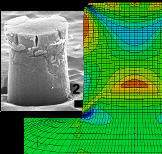Accueil > Plastic deformation of amorphous silicates > Why plastic ?
Why plastic ?
samedi 10 mai 2014, par
The plasticity of amorphous silicates
People have dreamt for a perfectly plastic glass material for millennia : plastic glass is one of the many colourful inventions strewn around Petronius’ Satyricon. In chapter LI, a glassmaker proudly presents the stunned emperor with a marvelous glassware, which, when thrown to the ground, does not shatter : the resulting bumps can even be mended with a hammer.
Indeed, brittleness actually results from a competition between plastic deformation and fracture. Hence for a given resistance to fracture (or toughness), a reduced brittleness may result from easier plastic deformation. Tempered steel is brittle...at the kilometer range (Y. W. Rhee et al., J. Am. Ceram. Soc. 84 (2001) 561).
Now glass does exhibit plastic deformations. The relevant lengthscale however is micrometric. Despite this fact, a singular feature of the ductile deformation of silicate glasses and most notably amorphous silica has been evidenced more than 30 years ago : it densifies (F. Ernsberger, J. Am. Ceram. Soc. 51 (1968) 545). In contrast to plastic deformation of metals, which occurs at constant volume, the plastic deformation of amorphous silica leads to permanent increase in density. Instead of deforming plastically by shear flow, silica deforms both by shear and by densification : the flow does not preserve the volume. The simplest evidence is that indented silica refracts visible light more than ordinary fused silica.
 MultiSil
MultiSil